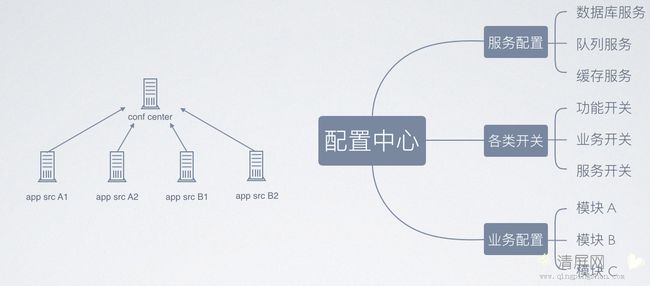一般服务器的应用都有以下几种类型,
其中当属业务部分最多也最繁杂。
当应用越来越庞大和复杂时,单机就肯定不能满足需求了,然后就要考虑分布式了,接下可能会应用不同的语言来开发应用。
比如 nginx 毫无疑问的是用的最多的反向代理组件,使用 OpenResty 便要用到 lua,再比如前端要 seo ,一个解决办法就是使用 nodejs,到了后端分布式,那就更繁多了,可能会需要把业务一个个拆分成不同的服务单独运行...
然后就发现散落一地的配置文件:***properties***、***yml***、***json*** …
这很好的解决了配置散落的问题,可以集中管理了,但是又存在另一个问题,各种类型的配置在一个文件里看起来好乱,而且在初始化时必须要完成这个文件才能启动应用。
所以下一个解决方案便想到用一个配置中心来解决问题。
Spring Cloud Config 项目
- 提供 服务端 和 客户端 支持
- 集中式 管理分布式环境下的应用配置
- 基于 Spring 环境,无缝 与 Spring 应用集成
- 可用于 任何 语言开发的程序
- 默认实现基于 git 仓库,可以进行 版本管理
- 可替换 自定义实现
Spring Cloud Config Server 作为配置中心服务端
- 拉取配置时更新 git 仓库副本,保证是最新结果
- 支持数据结构丰富,yml, json, properties 等
- 配合 eureke 可实现服务发现,配合 cloud bus 可实现配置推送更新
- 配置存储基于 git 仓库,可进行版本管理
- 简单可靠,有丰富的配套方案
Spring Cloud Config Client 默认客户端实现
- SpringBoot 项目不需要改动任何代码,加入一个启动配置文件指明使用 ConfigServer 上哪个配置文件即可
简单使用示例
新建一个 git 仓库,添加一个配置文件。例如想要一个 billing的服务,性质是开发,运行环境是测试环境。
那么就新建一个 testing 的分支,然后提交一个 billing-dev.properties 的文件
devMode = true spring.application.name = billing spring.jdbc.host = localhost spring.jdbc.port = 3306 spring.jdbc.user = root spring.jdbc.password = 123qwe loging.file = demo
然后新建一个标准 maven 项目
![]()
ConfigServer.java
@SpringBootApplication @EnableConfigServer public class ConfigServer { public static void main(String[] args) { SpringApplication.run(ConfigServer.class, args); } }
application.yml
server: port: 8888 spring: cloud: config: server: git: uri:https://git.coding.net/tiangao/demo-config-server.git clone-on-start: true
pom.xml
xml version="1.0" encoding="UTF-8"?>
xmlns="http://maven.apache.org/POM/4.0.0"
xmlns:xsi="http://www.w3.org/2001/XMLSchema-instance"
xsi:schemaLocation="http://maven.apache.org/POM/4.0.0 http://maven.apache.org/xsd/maven-4.0.0.xsd">
好了,配置中心已经可以启动了,配最简单的可以用浏览器来访问。
还有 yml, properties
![]()
OK, 就是这样简单。不过直接就能通过 url 得到,是不是有点不安全,这也不难,加上依赖。
java org.springframework.boot spring-boot-starter-security
然后在 application.yml 配置用户名和密码,user 便是用户名。
security:
user:
password: db1ab002-1fba-476d-a421-22113355
再访问就能看到如下的效果
这是 ConfigSever 默认实现的基本的 HttpBasic 的认证。
服务端好了现在来看看 SpringBoot 客户端
只需要添加一个启动配置文件:
java cloud: config: uri: http://127.0.0.1:8888 profile: dev label: testing name: billing password: db1ab002-1fba-476d-a421-22113355 username: user
呐,就是这样,所有的配置都通过仓库来管理,应用启动时访问配置中心能拿到自己的配置就OK,再接下来就是各自的事情了。
仓库也不仅仅只能用 git, 还有 svn 和本地目录可以选择
- svn://\${user.home}/config-repo
- file://${user.home}/config-repo
从简单的示例里可以看出,我们只要提交一种格式的配置文件,通过不同的方式访问即可得到不同格式的配置文件,这在ConfigServer里是如何实现的呢?
先看一共有多少种访问方式
- /{name}/{profiles:.*[^-].*}
- /{name}/{profiles}/{label:.*}
- /{name}-{profiles}.properties
- /{label}/{name}
- /{profiles}.properties
- /{name}-{profiles}.json
- /{label}/{name}-{profiles}.json
然后就能发现有这么一个类,里面有各种资源类型的转换操作。EnvironmentController 的所有方法如下所示:
原来内部只存在一种资源抽象,所有的资源对象都是由这种类型转换而来。
一个应用的配置只需要应用名、属性和标签就可以定位到。嗯,原来这么简单,那 EnvironmentReposiroty 又是哪里实现呢?
findOne 方式在 AbstractScmEnvironmentRepository 中可以找到。
java @Override public synchronized Environment findOne(String application, String profile, String label) { NativeEnvironmentRepository delegate = new NativeEnvironmentRepository( getEnvironment()); Locations locations = getLocations(application, profile, label); delegate.setSearchLocations(locations.getLocations()); Environment result = delegate.findOne(application, profile, ""); result.setVersion(locations.getVersion()); result.setLabel(label); return this.cleaner.clean(result, getWorkingDirectory().toURI().toString(), getUri()); }
这其中又由 SearcPathLocator 接口的 getLocations() 来实际加载内容,这个方法就由具体的实现类来完成。
Spring Cloud Config Server 内部除了 JGitEnvironmentRepository 实现外还有另外三种实现。
- SvnKitEnvironmentRepository
- NativeEnvironmentRepository
- MultipleJGitEnvironmentRepository
见名知其意,分别是 svn 本地目录以及多 git 仓库的实现。
来到客户端这边,SpringBoot
项目只需要加载依赖就可以使用到远程配置,现有项目迁移过去也不用改动任何代码,感觉好神奇。
达到这样的效果依赖于 springMVC 的抽象以及 springboot 的自动配置类加载。
```java
@Configuration
public class ConfigClientAutoConfiguration {
@Bean public ConfigClientProperties configClientProperties( Environment environment, ApplicationContext context) {...} ... @Bean public ConfigServerHealthIndicator configServerHealthIndicator( ConfigServicePropertySourceLocator locator, ConfigClientHealthProperties properties, Environment environment) { return new ConfigServerHealthIndicator(locator, environment, properties); } ...
}
**ConfigClientAutoConfiguration** 这个是 ConfigClient 的自动配置类,加载时触发新建一个 ConfigServicePropertySourceLocator 的 bean, java
@Order (0)
public class ConfigServicePropertySourceLocator
implements PropertySourceLocator {
private RestTemplate restTemplate; private ConfigClientProperties defaultProperties; ... @Override @Retryable(interceptor = "configServerRetryInterceptor") public org.springframework.core.env.PropertySource locate( org.springframework.core.env.Environment environment) { ... // Try all the labels until one works for (String label : labels) { Environment result = getRemoteEnvironment(restTemplate, properties, label.trim(), state); ...
}
```
然后在 ApplicationContextInitializer 的 initialize 方法中被调用 locate 方法从 ConfigServer 拉取配置文件,注入到 ConfigurableEnvironment 中,
@Configuration @EnableConfigurationProperties(PropertySourceBootstrapProperties.class) public class PropertySourceBootstrapConfiguration implements ApplicationContextInitializer<ConfigurableApplicationContext>, Ordered { ... @Override public void initialize(ConfigurableApplicationContext applicationContext) { ... ConfigurableEnvironment environment = applicationContext.getEnvironment(); for (PropertySourceLocator locator : this.propertySourceLocators) { PropertySource source = null; source = locator.locate(environment); if (source == null) { continue; } ... } ... } }
接着才是应用的初始化过程。
从这个过程可以看到,其他任何应用需要使用 ConfigServer 时只需要在应用初始化之前通过 http 拉取到配置文件即可。
了解了大致原理,便可以看到集中式管理的优点。
-
没有记忆负担:大家都使用一个仓库保存所有配置文件,方便查看。
-
降低冲突沟通成本:开发新功能是凡是有配置变动均向仓库的提交,在合并后其他人碰到配置问题时也不用到处找人问,看看仓库历史就知道什么发生了变化。
-
方便测试:测试环境下,测试人员也不用老是问开发环境配置的问题了,所有配置一目了然,更改配置也有记录,有问题向开发反馈也能帮助快速定位问题范围。
-
方便管理: 在模拟环境和生产环境下,通过分支保护和权限管理管理线上配置文件,由运维人员来管理。







